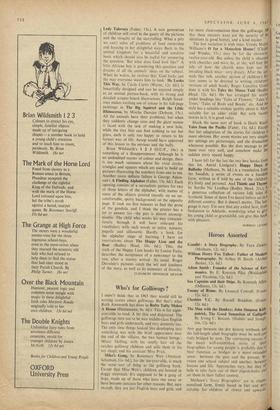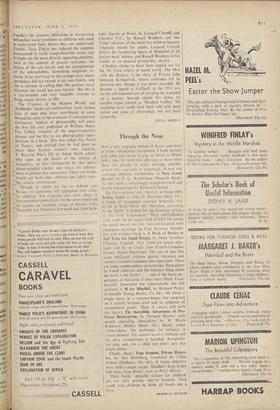Heroes Assorted
Gandhi : A Story Biography. By Taya Zinkin• (Methuen, 12s. 6d.) dens thor
Sea Captains and their Ships. By Kenneth A (Odhams, 13s. 6d.) Ilen.
Enemy of Rome. By Leonard Cottrell. (Evans, 12s. 6d.)
The Man with the Donkey: John Simpson Kirk patrick, The Good Samaritan of Gallipoli' By Irving C. Benson. (Hodder and Sic ugh" ton, 12s. 6d.)
ANY gap between the dry history textbook and the full-length adult biography must be well and truly bridged by now. The continuing success of the many well-established series of short biographies for young people is probably due 10 their function as bridges in a more extended sense: between the past and the present, be tween one school subject' and another, between lessons and life. Approaches vary, but they all help to take facts out of their pigeon-holes and set them in their fullest context.
Methuen's 'Story Biographies' arc in simPlc.' novelised form, firmly based in fact and veil suitable for children of eleven and upwards'
Gandhi's life presents difficulties in interpreting unfamiliar social problems to children who need to understand India before they can understand Gandhi. Taya Zinkin has reduced the complex background to fairly comprehensible terms, and brought out the more directly appealing elements, such as the concept of passive resistance, the drama of the salt march, and the championship of the untouchables. Something enigmatic re- mains in her portrayal of this strange man, whose gentleness did not extend to his own family, and she is extreme in calling him the greatest social reformer the world has ever known.' But this is a fair-minded and very readable attempt to bring recent history to life.
The 'Creators of the Modern World' and 'Pathfinder' books are well-written, fairly formal lives of men who have contributed in some Immediate sense to the evolution of contemporary civilisation. Addicts of photography will enjoy the first life ever published of William Henry Fox Talbot, inventor of the negative-positive process and the first to use photographic repro-
ductions in a book. This was called The Pencil of Nature, and stressed that he had done no more ' than harness nature's own capacity.
E. Royston Pike's life of Adam Smith admir- ably sums up the basics of the science of economics, as first formulated by this quiet, absent-minded scholar, and relates his achieve- ment to present-day experience. These two books would suit both older children and adults seek- mg concise information.
Though as adults we like to debunk our heroes, we apparently still appreciate their value ,iP children. Sea Captains and their Ships is ' recommended particularly for the notes which set iu context an excellent range of heroes, from Grenville and Nelson to Harwood and John Ken- nedy. Enemy of Rome, by Leonard Cottrell, and Cheshire V.C., by Russell Braddon, are two `Cadet' editions, all the better for children because criginally meant for adults. Leonard Cottrell divests the fascinating figure of Hannibal of all history-book tedium, and Russell Braddon writes vividly of an unusual present-day idealist.
Cheshire claims to have been singled out for the VC from others of equal worth. The Man with the Donkey is the story of Private John Simpson Kirkpatrick, whose comrades felt he deserved one, though it was never awarded. He became a legend at Gallipoli in the 1914 war for his self-imposed task of carrying the wounded on a donkey through enemy fire down the terrible slopes known as 'Shrapnel Gulley.' His touching story could have been told with more polish and sense of chronology, but not more sympathy.
STELLA RODWAY



































 Previous page
Previous page